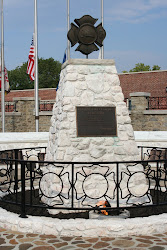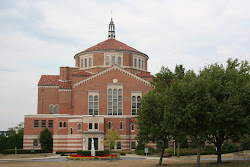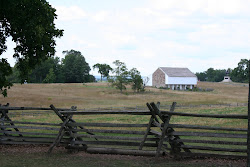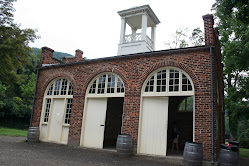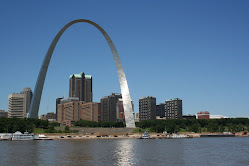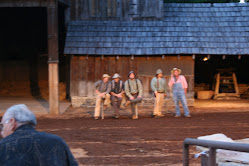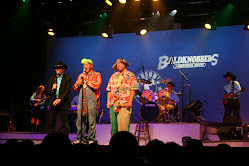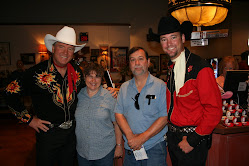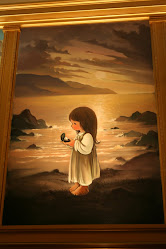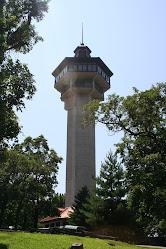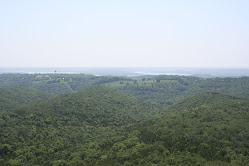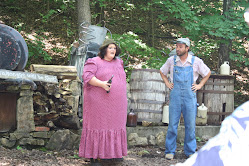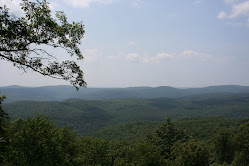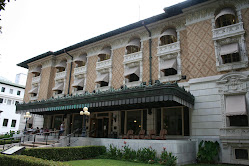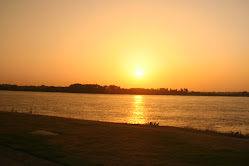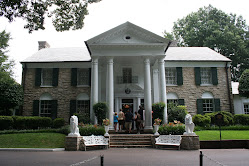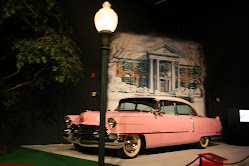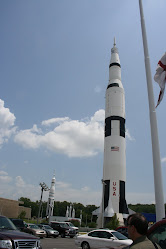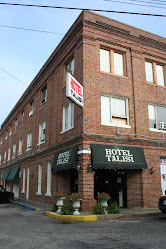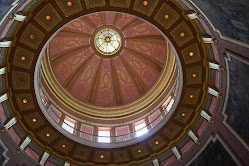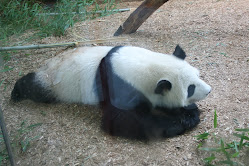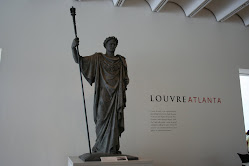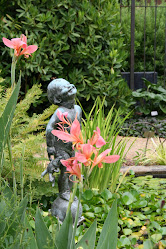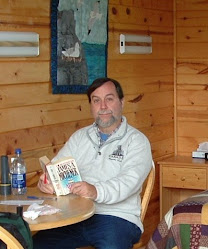Saturday, August 23, 2008
Home again...
Great trip. 15 states (not including NJ). 31 days. 3,117 miles. $629 in gas. And we reached our goal of having visited 49 of the 50 states. On the other hand, we also found that there are five states that we have been in, but not really explored (New Mexico - if you don't count putting your foot in at 4 corners; Texas, except by train and I-40; Kansas (I-70 and lots of cornfields); Oklahoma; and Mississippi (except a midnight bus stop in Biloxi). So we still have lots to explore in depth. And, of course, Hawaii.
Monday, August 18, 2008
Final Serendipity
Written from home in NJ:
As I've noted, we occasionally take a moment out of our planned itinerary because a sign said that something vaguely interesting was just off to the right or left. Our final testament to this came from three places, all spiritual and inspiring.
The National Fallen Firefighters Memorial. When our brother Joe died last year, one of the ways to remember him was to contribute to this small memorial in Emmittsburg, Maryland, just south of Gettysburg. As we made our way toward the battlefield, a sign told us of the memorial. It is on the grounds of the National Fire Training Academy (formerly the College of the Daughters of Charity) and the headquarters of FEMA, whom I'm sure you recall from Hurricane Katrina days. Because it is federal property, you need to sign in and wear visitor tags. But the memorial is lovely and touching in its simplicity and worth the visit. An eternal flame reminds us of how many of these men and women met their end. Plaques note the year and state they were from. One plaque by itself lists the names of the firefighters in NYC on 9/11. Nearby, a 20 foot sculpture depicts the famous picture of firemen raising the flag at Ground Zero.
Right next door is the Shrine of St. Elizabeth Ann Seton, aka Mother Seton. Her shrine is an expansive basilica, decorated with mosaic and stained glass. A side altar allows a brief prayer to the saint, whose earthly remains are buried a few feet below the altar. The lower level is a testament to her life: her marriage and early widowhood; her conversion from the Episcopal Church; her founding of the Daughters/Sisters of Charity and its work in schools and healthcare.
Again, a beautiful and inspiring center of contemplation.
St. Meinrad's Abbey, Indiana. Most of us at some point have run into the catalog from "Abbey Press" with its quasi-religious posters or sayings and collectibles. As we drove along I-64, there was a sign for St. Meinrad, the town. Since we get the catalog, Patty recognized the name. It is an abbey of Benedictine Monks who work on two basic businesses: the books, posters et al; and caskets. They also have a beautiful church, built in 1904 and remodeled in the 1990s. We stumbled onto a tour being given by one of the monks, so that we were able to get a first-hand look at the church, the lower chapel (which evokes the Byzantine rite), and the garden, for which our tour guide was the primary caretaker.
The visits made us slightly late for our intended destinations, but I look forward to more traveling where time is not of the essence and we can folow the rules of serendipity as we will.
As I've noted, we occasionally take a moment out of our planned itinerary because a sign said that something vaguely interesting was just off to the right or left. Our final testament to this came from three places, all spiritual and inspiring.
The National Fallen Firefighters Memorial. When our brother Joe died last year, one of the ways to remember him was to contribute to this small memorial in Emmittsburg, Maryland, just south of Gettysburg. As we made our way toward the battlefield, a sign told us of the memorial. It is on the grounds of the National Fire Training Academy (formerly the College of the Daughters of Charity) and the headquarters of FEMA, whom I'm sure you recall from Hurricane Katrina days. Because it is federal property, you need to sign in and wear visitor tags. But the memorial is lovely and touching in its simplicity and worth the visit. An eternal flame reminds us of how many of these men and women met their end. Plaques note the year and state they were from. One plaque by itself lists the names of the firefighters in NYC on 9/11. Nearby, a 20 foot sculpture depicts the famous picture of firemen raising the flag at Ground Zero.
Right next door is the Shrine of St. Elizabeth Ann Seton, aka Mother Seton. Her shrine is an expansive basilica, decorated with mosaic and stained glass. A side altar allows a brief prayer to the saint, whose earthly remains are buried a few feet below the altar. The lower level is a testament to her life: her marriage and early widowhood; her conversion from the Episcopal Church; her founding of the Daughters/Sisters of Charity and its work in schools and healthcare.
Again, a beautiful and inspiring center of contemplation.
St. Meinrad's Abbey, Indiana. Most of us at some point have run into the catalog from "Abbey Press" with its quasi-religious posters or sayings and collectibles. As we drove along I-64, there was a sign for St. Meinrad, the town. Since we get the catalog, Patty recognized the name. It is an abbey of Benedictine Monks who work on two basic businesses: the books, posters et al; and caskets. They also have a beautiful church, built in 1904 and remodeled in the 1990s. We stumbled onto a tour being given by one of the monks, so that we were able to get a first-hand look at the church, the lower chapel (which evokes the Byzantine rite), and the garden, for which our tour guide was the primary caretaker.
The visits made us slightly late for our intended destinations, but I look forward to more traveling where time is not of the essence and we can folow the rules of serendipity as we will.
Trying to Understand the Civil War
The Civil War has been an integral part of our travels, even though that was not a primary objective. We began, of course, in Atlanta, whose burning by Sherman's troops was an important event in bringing the war to a close and "Gone With the Wind" to a climax. We spent some time in Montgomery, where the vote for Alabama to secede was held. We saw various signs for battlefields off the interstates. And then came two very different and geographically close sites: Harper's Ferry, West Virginia and Gettysburg, Pennsylvania.
Harper's Ferry was the site of the attempted rebellion led by John Brown in 1859. Incensed by slavery, he attacked an armory there to try to get weapons for a slave rebellion. To some, he was a scoundrel - daring to attack the government itself, not knowing an even greater rebellion lay less than two years away. To others, he was a hero. When something is held to be morally wrong, some believe that you must do everything in your power to stop it; even violence. In 1861, after South Carolina, Virginia, and Alabama led the way to the formation of the Confederacy, Harper's Ferry was once again the scene of violence, with the armory and most of the town being laid to waste in bloody battles by the North and South.
A study in contrast is Gettysburg, only about two hours to the north, just over the famed Mason-Dixon Line that separates Maryland from Pennsylvania. The town of Gettysburg was smack in the middle of the bloodiest battle of the war, yet only one citizen was killed by a stray bullet (Jennie Wade, for those trivia fans out there). The battle lasted three days, with luck and a few bad decisions (Pickett's Charge, for example), deciding victory for the North. Yet on July 4, 1863, so many dead bodies lay strewn around the farms that they were often buried on the spot they died. Later, local officials decided to bury them just outside their local cemetery (which had even been the site of a battle itself - Cemetery Ridge). Within 5 months, it had become a National Cemetery and was dedicated by the great orator of the day Edward Everett, and the president, Abraham Lincoln. Everett spoke for two hours; Lincoln for two minutes. Everett was hailed by the press; Lincoln was ridiculed for his "silly comments" (which, by the way, was not composed on the back of an envelope). Which do we remember? There's a lesson to be learned somewhere in there.
Thousands died in those three days - 5000 alone in Pickett's Charge. Some from as far away as Indiana, Texas, and the Nebraska territory. For something they believed in: states' rights or union. I'm not sure I could or would do the same.
Harper's Ferry was the site of the attempted rebellion led by John Brown in 1859. Incensed by slavery, he attacked an armory there to try to get weapons for a slave rebellion. To some, he was a scoundrel - daring to attack the government itself, not knowing an even greater rebellion lay less than two years away. To others, he was a hero. When something is held to be morally wrong, some believe that you must do everything in your power to stop it; even violence. In 1861, after South Carolina, Virginia, and Alabama led the way to the formation of the Confederacy, Harper's Ferry was once again the scene of violence, with the armory and most of the town being laid to waste in bloody battles by the North and South.
A study in contrast is Gettysburg, only about two hours to the north, just over the famed Mason-Dixon Line that separates Maryland from Pennsylvania. The town of Gettysburg was smack in the middle of the bloodiest battle of the war, yet only one citizen was killed by a stray bullet (Jennie Wade, for those trivia fans out there). The battle lasted three days, with luck and a few bad decisions (Pickett's Charge, for example), deciding victory for the North. Yet on July 4, 1863, so many dead bodies lay strewn around the farms that they were often buried on the spot they died. Later, local officials decided to bury them just outside their local cemetery (which had even been the site of a battle itself - Cemetery Ridge). Within 5 months, it had become a National Cemetery and was dedicated by the great orator of the day Edward Everett, and the president, Abraham Lincoln. Everett spoke for two hours; Lincoln for two minutes. Everett was hailed by the press; Lincoln was ridiculed for his "silly comments" (which, by the way, was not composed on the back of an envelope). Which do we remember? There's a lesson to be learned somewhere in there.
Thousands died in those three days - 5000 alone in Pickett's Charge. Some from as far away as Indiana, Texas, and the Nebraska territory. For something they believed in: states' rights or union. I'm not sure I could or would do the same.
Wednesday, August 13, 2008
Homogenized America
I occasionally have mixed emotions as I drive the highways and byways of the USA. No matter where you go, there may be a Walmart, or Home Depot, or Sears, Target, or J.C. Penney. There are Borders Books and Staples; "Mall West" here and "Mall East" there. There are, of course, McDonalds and Burger Kings, Wendy's, Cracker Barrels, and several Pizza Huts, even right here on the "country roads, West Virginia...." On the one hand, it's comforting. This is America. Even though we travels hundreds of miles from our home state, we are in the same land. Whether it's New Jersey or Missouri, we can count on the same products, the brand names we trust and purchase back home. While there are the occasional regional choices - Bass Pro Shops (for hunting/fishing/camping enthusiasts) as opposed to L.L. Bean; some restaurants differ slightly in their menus - there's no pulled pork like that of Memphis; you can't get biscuits and sausage gravy in too many places up north. But most of the time, if you drive just a little farther, you can find the store just like "back home".
On the other hand, it's also a little like listening to rap in Ireland. What has happened to our regional identities? Is there no more "South" or "West"? Just America? And is that a bad thing?
On the other hand, it's also a little like listening to rap in Ireland. What has happened to our regional identities? Is there no more "South" or "West"? Just America? And is that a bad thing?
Monday, August 11, 2008
Go East, retired man
The circle is starting back, as we head east for the first time since Atlanta. It's somehow fitting that we do that by going backward through the Gateway of the West - St. Louis, Missouri. And even more fitting that we mark the occasion by ascending in the Gateway Arch (real name: Jefferson National Expansion Memorial) which we first observed (almost 32 years ago to the day) as we drove west on our honeymoon. The Arch is 630 feet above the Mississippi River, built in 1965. You ascend in a small (about 5' high) tram car that takes 4 minutes to reach the top where you can then look 50 miles east and west. A brief side trip before St. Louis had continued our literary tour, this time to the home of Laura Ingalls Wilder, known for the "Little House" book series, who lived most of her 90 years in this house. The visit gave a new appreciation for the books, and introduced me to her daughter - Rose Wilder Lane - who was also quite the writer. Her "most famous novel" was "When the Hurricane Blows" aka "The Young Pioneers". She was a news correspondent right up to the Vietnam War before her death in 1968.
PS: IF YOU WANT TO READ THE BEGINNING OF THE TRIP POSTS, SCROLL DOWN AND SELECT "OLD POSTS". THE PICTURES ALL STAY IN ORDER, BUT THE POSTS DON'T.
PS: IF YOU WANT TO READ THE BEGINNING OF THE TRIP POSTS, SCROLL DOWN AND SELECT "OLD POSTS". THE PICTURES ALL STAY IN ORDER, BUT THE POSTS DON'T.
Saturday, August 9, 2008
Fueling Around
One of the jokes from the Baldknobber crew goes like this:
- What separates Illinois from Missouri?
- About 40 cents per gallon!
When we left NJ, we'd heard that Missouri had the cheapest gas in the nation on average. And it's true. Of course, as we've traveled, gas prices have been coming down anyway. My fill-up pre- leaving NJ was $3.93 per gallon, off-brand. In Virginia and the Carolinas, it hovered in the same area - only once going over the $4 mark and that was near Baltimore-DC. Alabama's prices were around $3.85; Arkansas a little less - we were able to fill up at a highway stop for $3.79. But Missouri has them all beat. The most expensive is here in Branson (get them tourists!) and it is $3.65 at name-brand stations. But while we traveled to Carthage, we actually got gas for $3.36! Now, I'm not sure if oil is just cheaper here or, like NJ, they have a low gas tax. But whatever, I'm filling up again before I hit Illinois...
- What separates Illinois from Missouri?
- About 40 cents per gallon!
When we left NJ, we'd heard that Missouri had the cheapest gas in the nation on average. And it's true. Of course, as we've traveled, gas prices have been coming down anyway. My fill-up pre- leaving NJ was $3.93 per gallon, off-brand. In Virginia and the Carolinas, it hovered in the same area - only once going over the $4 mark and that was near Baltimore-DC. Alabama's prices were around $3.85; Arkansas a little less - we were able to fill up at a highway stop for $3.79. But Missouri has them all beat. The most expensive is here in Branson (get them tourists!) and it is $3.65 at name-brand stations. But while we traveled to Carthage, we actually got gas for $3.36! Now, I'm not sure if oil is just cheaper here or, like NJ, they have a low gas tax. But whatever, I'm filling up again before I hit Illinois...
Baldknobbers?
After the Civil War, a vigilante group set themselves up to patrol the unruly wilderness in the Ozarks - the place that fueled the popular image of Hillbillies and the feuding MacCoys and Lil Abner. These guys adopted masks to conceal their identities from neighbors and called themselves "Bald Knobbers", after the nearly treeless hills or knobs that are in this area. Then, as so many law-enforcement groups do, they were corrupted by their power and became abusive criminals themselves. In the 1950s, as Branson was just catching on as an entertainment capital, a group of locals began to perform an outdoor drama version of the book, "Shepherd of the Hills", which apparantly was very popular in the early 20th century. It's a classic love story set against this lawless era - think "Oklahoma" with hills. Part of this performance included a barn dance backed up by blue grass musicians. A few years later, these musicians began performing in one of the newly opened theatres. Someone recognized them as the guys who played the baldknobbers in the play and they thought it sounded like a great name for the group. Today, almost 50 years later, they - the Mabe family and friends - are still playing, in their own theatre. They play mostly country-style music - no blue grass anymore - and have added a variety of hillbilly comics, with names like Willie Makeit, Hargus - the sad sack face, Droopy Drawers - think Tim Conway, and Stub, who can actually put his lip over his nose! Their humor is vaudevillean, usually based on the stupidity of either Hargus or Stub. ("If you had $13 in one pocket, and $12 in the other, what would you have?" "Somebody else's pants!") though it is occasionally topical: "You know there isn't really any oil shortage. We have oil, we just can't measure it." "Really, why is that?" "All the dipsticks are in Washington." (cymbal crash please)
But here's my favorite: A man goes to a revival meeting and says he's worried about his hearing. The minister placed his hands over the man's ears and prayed that he be healed. After a half an hour of prayer, the minister says "So how's you hearing?" The man says "I don't know. It doesn't come until Tueday at the court house!"
Other shows we enjoyed: The Showboat Branson Belle, a recreated sternwheeler, that features the classic foursome of two gals and two guys singing the hits of Broadway, as well as a ventriloquist who works with real dogs and even brings people up on stage, "throwing " his voice into theirs as he squeezes the back of their necks and they open their mouths. It was really fun, though we felt sorrier for the dogs than we did the people.
Roy Rogers, Jr. - the son of the Son of the Pioneer who does a decent job of telling his father's story and singing some of his songs. There is a museum attached that has Trigger (stuffed) and the old Lillybelle jeep from the TV show.
The Presleys: they were the other family that "started Branson". Outstanding musicians and vocalists, they tried their hand at comedy as well, often with the same jokes we'd heard earlier. But it was a good show.
The World's Largest Toy Museum with a million toys and artifacts of our youth. It could use a slightly better labeling system - there are a number of times when you say "what is that?" or "I wonder how old that is?" But I've never seen so many miniature cars, trucks, games, dolls etc. And then there's Titanic: the outside of which resembles half of the ship and the inside has a rebuilt "grand staircase" and state rooms - both first and third class, plus a room about the film, with behind the scenes video and costumes and props from the film version, and a lot of stories from survivors and early passengers who were lucky enough to have disembarked in Ireland.
All in all, lots of things to see and do. We even took an extra two hour side trip to go to Carthage, Mo, for the "Precious Moments" museum and chapel. Those little large-eyed figurines have done well. Sam Butcher, their creator, has built a chapel there with murals depicting, in figurine-like drawings, his slightly humorous view of heaven, the Beatitudes, and various tales from the Bible.
Still more proof that "no matter where you go..."
But here's my favorite: A man goes to a revival meeting and says he's worried about his hearing. The minister placed his hands over the man's ears and prayed that he be healed. After a half an hour of prayer, the minister says "So how's you hearing?" The man says "I don't know. It doesn't come until Tueday at the court house!"
Other shows we enjoyed: The Showboat Branson Belle, a recreated sternwheeler, that features the classic foursome of two gals and two guys singing the hits of Broadway, as well as a ventriloquist who works with real dogs and even brings people up on stage, "throwing " his voice into theirs as he squeezes the back of their necks and they open their mouths. It was really fun, though we felt sorrier for the dogs than we did the people.
Roy Rogers, Jr. - the son of the Son of the Pioneer who does a decent job of telling his father's story and singing some of his songs. There is a museum attached that has Trigger (stuffed) and the old Lillybelle jeep from the TV show.
The Presleys: they were the other family that "started Branson". Outstanding musicians and vocalists, they tried their hand at comedy as well, often with the same jokes we'd heard earlier. But it was a good show.
The World's Largest Toy Museum with a million toys and artifacts of our youth. It could use a slightly better labeling system - there are a number of times when you say "what is that?" or "I wonder how old that is?" But I've never seen so many miniature cars, trucks, games, dolls etc. And then there's Titanic: the outside of which resembles half of the ship and the inside has a rebuilt "grand staircase" and state rooms - both first and third class, plus a room about the film, with behind the scenes video and costumes and props from the film version, and a lot of stories from survivors and early passengers who were lucky enough to have disembarked in Ireland.
All in all, lots of things to see and do. We even took an extra two hour side trip to go to Carthage, Mo, for the "Precious Moments" museum and chapel. Those little large-eyed figurines have done well. Sam Butcher, their creator, has built a chapel there with murals depicting, in figurine-like drawings, his slightly humorous view of heaven, the Beatitudes, and various tales from the Bible.
Still more proof that "no matter where you go..."
Wednesday, August 6, 2008
Branson, MO
We are only midway through our stay in Branson and, so far, it is well worth the trip. We missed several of our favorite "oldies", as they have chosen our vacation time to take their own - so Andy Williams, and Bobby Vinton, the Lennon Sisters (from Lawrence Welk) and even Shoji Tabuchi is off relaxing this week. Who? He's sort of a made-in-Branson star who apparantly puts on one hell of a show. We even missed Paul Revere and the Raiders because we were just too tired to get out for our first night and their last performance here.
So, what to do? Well, we decided that we did not want to see the imitation acts - the Elvis impersonators, the Liverpool Lads, the "salute to the 60s" etc. We'd prefer original performers - so last night we went to see Jim Stafford. Like other performers here, he had one big hit in the 70s called "Spiders and Snakes", but apparantly made enough money to buy himself a theater. He , and his two children, do some music; he's an incredible guitar player; and a sort-of stand-up comedy - "Welcome to Branson. That's an old Indian word for 'bumper-to-bumper'" he explains, referring to the tendency here to wait through several changes of traffic lights out on "the strip". Earlier, we were treated to some more downhome Southern "hillbilly" humor when we explored the Homestead at "Shepherd of the Hills", an historic site that was the basis for the best selling novel that I'd never really heard of until I got here. But I'm told that it is the fourth best-seller in the US, and it was the basis of four movies. It is also the basis for one of those huge outdoor dramas, with 100 actors and live animals telling the tale. We'll see the show on Friday, but meantime we explored the site and took a trip up Inspiration Tower, a 230 foot high extension above the Ozarks, looking down on "Mutton Hollow" and the Bald Knob - a treeless hill whose name will be significant later. From the enclosed viewing area, we were alongside a few turkey vultures and actually looked down on a red shouldered hawk flying by!
Bald Knob gives its name to a group of vigilantes who ruled the area in the post Civil War days and also to another musical comedy act that was one of the first performers in the developing Branson entertainment area.
So, what to do? Well, we decided that we did not want to see the imitation acts - the Elvis impersonators, the Liverpool Lads, the "salute to the 60s" etc. We'd prefer original performers - so last night we went to see Jim Stafford. Like other performers here, he had one big hit in the 70s called "Spiders and Snakes", but apparantly made enough money to buy himself a theater. He , and his two children, do some music; he's an incredible guitar player; and a sort-of stand-up comedy - "Welcome to Branson. That's an old Indian word for 'bumper-to-bumper'" he explains, referring to the tendency here to wait through several changes of traffic lights out on "the strip". Earlier, we were treated to some more downhome Southern "hillbilly" humor when we explored the Homestead at "Shepherd of the Hills", an historic site that was the basis for the best selling novel that I'd never really heard of until I got here. But I'm told that it is the fourth best-seller in the US, and it was the basis of four movies. It is also the basis for one of those huge outdoor dramas, with 100 actors and live animals telling the tale. We'll see the show on Friday, but meantime we explored the site and took a trip up Inspiration Tower, a 230 foot high extension above the Ozarks, looking down on "Mutton Hollow" and the Bald Knob - a treeless hill whose name will be significant later. From the enclosed viewing area, we were alongside a few turkey vultures and actually looked down on a red shouldered hawk flying by!
Bald Knob gives its name to a group of vigilantes who ruled the area in the post Civil War days and also to another musical comedy act that was one of the first performers in the developing Branson entertainment area.
Monday, August 4, 2008
Hot Springs and other things
Several people, when presented with the fact that we would explore Arkansas on this trip, responded with "why Arkansas? Beyond so you can brag about being in 49 of the states?" Well, I'm back to my theory about "no matter where you go..."
Out of Alabama, we moved quickly through the main part of Arkansas - it's in the plains and there is not much scenery beyond the cornfields and cotton plants. A little like Kansas, except for the cotton. We were tempted to stop in Little Rock: Capitol/capital; Civil Rights center; a national cemetary; Bill Clinton's Presidential Library - all kinds of possibilities, but we'll save that for another trip. When it's not 100 degrees out.
Instead, we reached the beginning of the mountain region. If you divide Arkansas with a diagonal through its almost-rectangular shape, the eastern side is flat; the western half has the Ozarks, a mountain range that is actually one large plateau separated by river valleys. Hot Springs is at the start of those mountains. Hot Springs was one of those towns that grew up from the - um, well - hot springs that pour out from its rock outcroppings. Very medicinal, you know. Especially in the late Victorian age when polite society could "take to the baths"; immerse themselves in about 100 degree water (it comes out of the ground at 140, but that's almost scalding, so they cool it down a little.) Bathhouses line Central Avenue (actually built over a hot creek) until bathing was less fashionable, a depression hit, and a war. But way back in the 1820s, the federal government recognized the need to preserve these forests and springs and Hot Springs was declared a national preserve - way before the concept of "national park" had developed with Yellowstone. Today, Hot Springs is a national park and its visitor center, since 1989, is one of the bath houses. The town hugs the park's boundaries and has several classic "hotel and spa" buildings left from the 20s. At various points in town, one can fill a jug with the natural waters ("it has no taste" explained a film in the visitor center. Well, duh, it's water.) People line up with gallon jugs (for sale in several local establishments for 73 cents or more) and some with five gallon jars, often a truck-load full. A drive up the north mountain takes you to an observation tower, about 760 feet above the town. A west mountain drive takes you to a more natural observation post.
A little further north is Eureka Springs, a similar town but without the national park designation. To get there, you drive through Dogpatch (it's on the map, but no road sign identifies it) and nearby Flippin (an article in a newspaper said to watch for the sign that says "Flippin Police..."), but we sped on towards Branson, mid-America's music capital, no matter Memphis might think.
Out of Alabama, we moved quickly through the main part of Arkansas - it's in the plains and there is not much scenery beyond the cornfields and cotton plants. A little like Kansas, except for the cotton. We were tempted to stop in Little Rock: Capitol/capital; Civil Rights center; a national cemetary; Bill Clinton's Presidential Library - all kinds of possibilities, but we'll save that for another trip. When it's not 100 degrees out.
Instead, we reached the beginning of the mountain region. If you divide Arkansas with a diagonal through its almost-rectangular shape, the eastern side is flat; the western half has the Ozarks, a mountain range that is actually one large plateau separated by river valleys. Hot Springs is at the start of those mountains. Hot Springs was one of those towns that grew up from the - um, well - hot springs that pour out from its rock outcroppings. Very medicinal, you know. Especially in the late Victorian age when polite society could "take to the baths"; immerse themselves in about 100 degree water (it comes out of the ground at 140, but that's almost scalding, so they cool it down a little.) Bathhouses line Central Avenue (actually built over a hot creek) until bathing was less fashionable, a depression hit, and a war. But way back in the 1820s, the federal government recognized the need to preserve these forests and springs and Hot Springs was declared a national preserve - way before the concept of "national park" had developed with Yellowstone. Today, Hot Springs is a national park and its visitor center, since 1989, is one of the bath houses. The town hugs the park's boundaries and has several classic "hotel and spa" buildings left from the 20s. At various points in town, one can fill a jug with the natural waters ("it has no taste" explained a film in the visitor center. Well, duh, it's water.) People line up with gallon jugs (for sale in several local establishments for 73 cents or more) and some with five gallon jars, often a truck-load full. A drive up the north mountain takes you to an observation tower, about 760 feet above the town. A west mountain drive takes you to a more natural observation post.
A little further north is Eureka Springs, a similar town but without the national park designation. To get there, you drive through Dogpatch (it's on the map, but no road sign identifies it) and nearby Flippin (an article in a newspaper said to watch for the sign that says "Flippin Police..."), but we sped on towards Branson, mid-America's music capital, no matter Memphis might think.
Subscribe to:
Comments (Atom)


